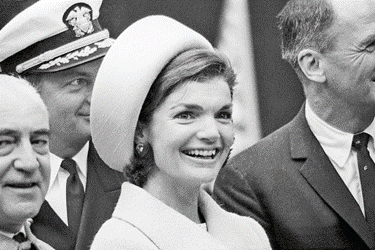The Stories Behind 7 Famous Hats From History
(I don't know how many hats I have but it must be many dozens -- almost of every kind, but only one of these seven kinds. I enjoyed this info, maybe you will, too. - Lynn)
“A person carries off the hat,” leading milliner
Philip Treacy (who’s made hats for British royals, Lady Gaga, and Kate Moss,
among others) once said. Whether it’s a topper adopted by the average person
or a custom piece worn by a celebrity, a hat reflects personality, style, and
practicality. Here are seven popular hats that have become linked to their most
famous wearers.
Jackie Kennedy’s Pillbox Hat
Small, round, and rigid, usually with a flat or
slightly rounded top, the pillbox hat emerged on American women’s heads
sometime in the early 20th century, but First Lady Jackie Kennedy made them
her own. During John F. Kennedy’s 1960 presidential campaign, she wore a white
pillbox by Givenchy in front of a crowd of 2 million people. She later sported
pillboxes by Halston, Oleg Cassini, and other American designers, and
established a new and modern look for mid-century America. The whereabouts of
the pink pillbox she wore when her husband was assassinated in 1963 — an indelible hat in American memory — are unknown.
George Washington’s Tricorn Hat
Whether or not you stuck a feather in it and called it
macaroni, the tricorn hat was a staple on patriots’ heads during the American Revolution. The three-cornered,
low-crowned hat grew out of the habit of military officers pinning
up (or “cocking”) their broad-brimmed hats on three sides to funnel
rain away. They became de rigueur for fashionable men in the
late 17th and 18th centuries in Europe and the American colonies. The tricorn
was usually worn with one
point forward and often decorated with lace, braids, or
feathers. George Washington wasn’t the only revolutionary to don
one, but he was likely the most recognizable among his countrymen.
A close relative of the tricorn hat was the bicorne
hat — a broad-brimmed, low-crowned hat cocked on two
sides. Most military personnel in the 18th century wore one of the corners
forward, but Napoleon sported the pinned side to the front, believing that it made him
appear approachable. One of the most reproduced portraits of the
general, Jacques-Louis David’s Napoleon Crossing the Alps, depicts him wearing his
signature chapeau. Napoleon remains so identified with the style
that several of his bicornes have sold at auction for stratospheric prices. The
one he is believed to have worn during his successful 1807 campaign sold for $1.4 million in September 2021.
As tricorn hats fell out of fashion, the top hat took
over. Championed by Regency dandy Beau Brummel, a confidante
of the future George IV, top hats were tall, flat-topped, narrow-brimmed, and
originally made of beaver felt; they were possibly modeled on the
17th-century capotain or
“Pilgrim hat.” Silk top hats became more common by the mid-19th century and
were worn by all respectable Victorian men. Abraham Lincoln was not alone in
wearing top hats to public events, but at 6 feet and 4 inches tall, plus an
8-inch hat, he really stood out in a crowd. The top hat Lincoln was wearing when
he was assassinated at Ford’s Theatre is one of the Smithsonian’s most treasured artifacts.
David Crockett — military scout, Tennessee politician,
and member of Congress — had a talent for spinning tales about his experiences
as a frontiersman. Following his death at Texas’s Alamo in 1836, numerous books, plays, and pamphlets embellished his skills as
a fearless hunter and sharpshooter in a raccoon-skin cap. Whether Crockett ever wore one
is debatable. But when Disney released the 1955 live-action
film Davy Crockett, King of the Wild Frontier, starring Fess Parker
in a coonskin cap, American boys went bananas for the rustic toppers. At the
height of Crockettmania, stores sold about 5,000 faux-fur coonskin caps a day.
Fedoras emerged in the 1880s, possibly based on an
earlier Alpine design of soft felt with a center crease and a pinch at the
front. Its debut closely followed the premiere of Victorien Sardou’s play Fédora,
and the name got attached to the hat. But fedoras really
entered the style pages in the 1920s, when flashy gangsters like Al Capone were rarely pictured without them in
newspapers and newsreels. Fedora fans copied Capone’s habit of wearing them
tilted on his head. Even after Prohibition ended in 1933, the style
remained associated with tough guys and shady types in novels
by Raymond Chandler and film noir pictures.
Winston Churchill’s Homburg Hat
One of the many hat styles popularized by European
royalty, the homburg originated in the German spa town of Bad Homburg in the 1880s. Some historians believe the
form, with a single crease at the crown, a wide grosgrain band, and a flat brim
with curled edges, was based on a traditional hunting hat from the region. The homburg
gained worldwide attention when the Prince of Wales (later Edward VII) wore them, but the person most associated with homburgs is
surely Winston Churchill. The British prime minister wore a gray homburg to the 1943 conference with
President Franklin Roosevelt in Casablanca, where the two leaders hashed out
a plan to end World War II. Churchill and the Homburg
remained linked in the public imagination thereafter.









.png.jpg)
No comments:
Post a Comment